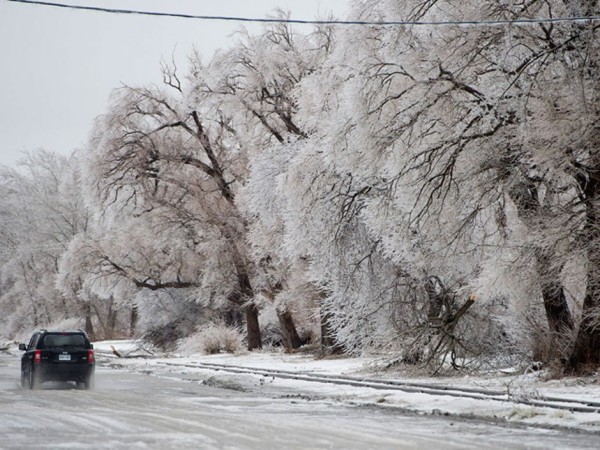Toronto ice storm leaves 300,000 with power
TORONTO — A steady dose of freezing rain across parts of Eastern Canada turned roads and sidewalks into skating rinks Sunday, cut power to hundreds of thousands of people, and played havoc with holiday plans at one of the busiest travel times of the year.
Anxious passengers found themselves stranded in airports from Toronto to St. John’s, N.L., days before Christmas. Some 300,000 households in Toronto are without power and Toronto Hydro says it may be 72 hours — Christmas Day — before it is restored.
The storm has knocked out the electricity to thousands homes and businesses and is creating massive headaches for travellers at one of the busiest travel times of the year.
“It truly is a catastrophic ice storm that we have had here, probably one of the worst we’ve ever had,” Toronto Hydro CEO Anthony Haines said Sunday. The worst hit parts of Toronto are the neighbourhoods near the 401, stretching the city from Etobicoke to Scarbourough.
The weather conditions have resulted in scores of flight cancellations and delays at airports in Toronto, Ottawa, Montreal, Fredericton, Saint John, N.B., Halifax and St. John’s, N.L.
Passengers are being advised to check their flights before heading to the airport. More than 163 flights were cancelled at Toronto’s Pearson Airport Sunday, about 21% of all flights. Most flights are delayed and many are cancelled at the Billy Bishop Toronto City Airport.
Toronto shut down streetcar service and there were delays and suspensions of GO and RT service as well.
“Subway trains are bypassing Yorkdale, York Mills, North York Centre, Islington and Victoria Park Stations due to ongoing power issues,” the TTC said Sunday evening.
The Toronto District School Board has closed all facilities for Monday, including childcare centres.
Police are asking people to stay off the roads Sunday.
“Driving conditions are hazardous. This is made worse by the fact that many traffic lights aren’t working. Please do not drive unless it is absolutely necessary,” police said in a statement.

The situation drew comparisons to the deadly ice storm that encased Quebec in 1998, as hydro crews across the region struggled to restore service.
“Some of the crews I’ve spoken to said this is as bad,” said Blair Peberdy, vice-president of Toronto Hydro.
“These storms tend to wreak havoc and we have to go street by street with chainsaws.”

Outages affecting an estimated 400,000 hydro customers were reported in Ontario, including 300,000 in the Greater Toronto Area, as ice-coated tree branches snapped, pulling down power lines.
Toronto Hydro says its phone lines are overwhelmed and is asking citizens to only call in cases of emergency.

Toronto Hydro said it could take up to 72 hours to get everyone reconnected.
Toronto Mayor Rob Ford’s Twitter account began sending out information at about 10:30 a.m. Sunday.
Salting and sanding crews worked through the night Saturday and into Sunday in an uphill battle against a dangerous mix of snow, ice pellets and freezing rain that stretched from Niagara Falls, Ont., to the Atlantic Coast.
Via Rail warned commuters to expect delays on its routes between Toronto and Montreal or Ottawa and police warned people to stay off the roads if possible.
“Thoughts are with those without power due to the ice storm,” Prime Minister Stephen Harper tweeted. “Please stay safe.”
In Toronto, where warming centres were set up, Mayor Rob Ford called it one of the worst storms in the city’s history.
“My house is freezing cold, I have little kids, we might have to go to a hotel tonight, I’m not quite sure what we’re going to do,” Ford said Sunday.
“It’s not good to wake up and have a freezing cold shower.”

“I want to assure everyone living in these areas that all available resources are working to keep you and your families safe and to restore power as quickly as possible,” Ontario Premier Kathleen Wynne said in a statement Sunday.
”We’re going to bring in the resources that are needed to deal with the situation,” Wynne told a news conference.
Hydro Quebec says nearly 29,000 customers are without power, mainly in the Estrie and Monteregie regions. There are only about 240 customers affected in Montreal. Most flights leaving the Trudeau Airport in Montreal are delayed.
At the height of the storm, Hydro Quebec said 49,000 customers were without power, mainly in the Estrie and Monteregie regions, while another 1,500 customers in Montreal found themselves in the dark.
Sherbrooke, located in the Eastern Townships, one of the hardest hit parts of the province, suspended all public transportation services.
NB Power reports 3,800 customers without electricity, with more than 3,600 in St. Stephen.
New Brunswick is blanketed in weather warnings, with up to 25 centimetres of snow expected in northern parts of the province by Monday.
Environment Canada says the trough of low pressure will bring a mixed bag of precipitation — snow, freezing rain and rain — to central New Brunswick.
Meteorologist Andy Firth says periods of freezing rain will persist across mainland Nova Scotia into Sunday evening, while rain is expected along the Atlantic coast and in southwestern regions of the province.
Firth says Prince Edward Island could see up to 25 centimetres of snow by Monday.
Dozens of flights at airports across the Maritimes have been delayed or cancelled on one of the busiest travel weekends of the year.
Salting and sanding crews worked through the night in an uphill battle against a dangerous mix of snow, ice pellets and freezing rain that stretches from Niagara Falls, Ont., to the Atlantic Coast.
The weather conditions are suspected to have been a factor in three fatal highway accidents in Quebec on Saturday, and another in Ontario.
Provincial police are strongly advising people not to drive unless it’s absolutely necessary.
As the storm continues its eastward march Environment Canada meteorologist Weiqing Zhang said it would likely be sometime this afternoon before it leaves central Canada and sometime this evening before freezing rain stops falling on the Maritimes.
At one point in January 1998, almost 10 per cent of the country’s population — about three million people — were without power when four days of intermittent freezing rain entombed parts of eastern Ontario, New Brunswick and western Quebec.
The Canadian Forces deployed 14,000 troops to help with the devastation, and damage at the time was pegged at more than $1 billion.
Marie-Eve Giguere, a meteorologist with Environment Canada, said the 1998 storm involved far more freezing rain than over the past few days.
“The event we’ve been experiencing this weekend is similar in the sense that it lasted several days and it was caused by a few storms riding along the same track,” Giguere said.
“However, we haven’t had as much in terms of precipitation and accumulation of ice.”
By Sunday afternoon, the storm had moved eastward but freezing rain was only expected to stop falling on the Maritimes late in the day, Environment Canada said.





The period above freezing will be brief, temperatures are forecast to fall below zero again as Monday progresses with the temperature looking to hit -10 by Christmas Eve.
Police block off an area with downed power lines. Peter J. Thompson/National Post


Christmas crowds gather at Pearson International Airport as holiday travel continues despite the ice storm. Photographs by James Martin/National Post


All streetcar service is still suspended due to icy power lines.
Toronto Hydro says situation has gotten worse. 300,000 without power.
“Downed power lines and trees can make repairs difficult & impact restoration times. Thank you for your patience. #darkto” Via Twitter
Full statement from Premier Wynne:
|







Leave a reply